Daytona Beach, Fla., Mar. 16—Daytona Bike Week began with a motorcycle race. But before the first Daytona 200 in 1937, beginning in the 1920s, motorcycles had migrated off the dangerous and deadly wooden board tracks they’d inherited from bicycle racing and moved to safer and more accessible dirt tracks.
Small towns, rural communities, and even big cities were carving oval tracks into convenient pieces of open land. And farm boys were going into their barns to strip down old Harleys, Indians, Excelsior-Hendersons or any of the other dozens of motorcycles brands built at that time to go a-racin’.
That’s where flat track racing was born. It was grassroots racing at its best: simple, loud, fast, dangerous, ridden on machinery built out of the same soil it is raced on, and accessible to everyone. A true American original.
Daytona’s early motorcycle races ran along the ocean’s edge, going north up the beach (it had to be scheduled to run at low tide) and back down south on highway A1A with a hairpin turn at each end. Other than needing brakes and a larger fuel tank those early racers were identical to the bikes being raced in the dirt all across America at the time.
In 1961 Daytona’s racing scene moved inland to the new track Bill France built on the outskirts of the young city and it planted deep roots. By the 70’s the Daytona 200 had evolved into the most prestigious motorcycle road race in the world and helped define Daytona as the world center of racing; the bikes had become sleek, lightweight, temperamental, specialized speed machines.
History was made this year at Daytona when flat frack racing came inside the Daytona International Speedway for the first time. Along with moving to the infield inside of Daytona’s high banks, other changes are happening with this year’s series: The recently-revived Indian Motorcycle company rejoined competition after a 60-some year break with a new purpose-built competition-only model and an all-star team called the Wrecking Crew, named after its most famous race team from the post-WW2 era. Harley introduced a new model replacing its long-in-the-tooth XR-750 along with an equally stellar team of riders. And the newly-revamped series, now named American Flat Track (AFT), premiered its simplified class structure and format, which is designed to make it easier to follow, and added a TV package to make the action accessible to all fans, old and new.

I’ve been going to Daytona for decades and got interested in the road racing about a dozen years ago. I got sucked in big time and have raced there myself in support classes, worked in the pits for friends who race, written about it, and now work on the safety crew. I camp at the track and rarely get any further from it than the closest restaurants and grocery store, so I’m pretty familiar with the current scene.
This year, driving out of the tunnel under the west banking towards the infield I felt an energy and excitement that hasn’t been there for many years. Early Thursday morning, the day of the Flat Track racing, RVs lined the access roads and filled all the available parking areas; none of my late-arriving friends could get their usual spots, and the campground was fuller than I’ve seen it in a long time. Most of those people I talked with were there for the inaugural AFT race (and many of them stayed for the road racing after).

After putting my tent up, going to our safety-crew meeting for the road racing and making a run for groceries, I wandered over to the garages where the flat track racers were set up. This was all new to me. I’d watched a few races on the 1/3-mile short track the Speedway had built outside the track a few years ago, but hadn’t really gotten into it. The action was exciting—watching a pack of angry bikes pitch sideways, barely under control, sliding into corners, bashing handlebars with each other while that loud roar of unmuffled exhaust we all love so much roared out over the crowd, carrying the scent of burnt race fuel to deep-breathing fans. It was fun but I didn’t know the riders, the teams, or their bikes; I really had no idea what was going on and it didn’t hold my interest beyond that evening’s entertainment.
But this year, probably because of the upcoming Harley-Indian battles, I’ve been paying attention, learning the sport, and getting excited about it. I guess I’m one of those that AFT is aiming its new program at—and it’s working.

Following the season opener in Daytona there will be 17 more races, including two in Sturgis during the Black Hills Rally in August: a TT at the Buffalo Chip Campground, and a Half-Mile at the Black Hills Speedway in Rapid City. Bit of trivia here—Sturgis began in 1938 as a dirt-track race sponsored by the local Indian dealer; nine riders raced. They were members of the Jackpine Gypsies Motorcycle Club, mounted on Indians, and were looking for Harley riders to beat.
The series runs on a variety of track layouts: Short Track, which is usually a third-mile or so; Half-Mile, Mile and the TT (Tourist Trophy). Six of the upcoming races will be Miles where bikes in the Twins Class can reach speeds up to 140 mph Half-Miles make up the majority with seven races; there are only two Short-Tracks and three TTs. The TT courses are laid out with right and left hand turns and a jump. Racers don’t use brakes on the ovals; the bikes don’t even have front brakes for those courses, but they are added for the TTs.
Daytona was a TT. It was a long and narrow track, shaped something like a paper clip someone had been playing with but lost interest in before totally bending it out of shape, built on the grass area between the pits and the tri-oval on the road course. It had a long straight with the finish line on the side closest to the grandstands under the tri-oval, a moderate hairpin on the west end with a quick left/right turn heading up a shallow incline with a mild jump just before the start, which led back up the front straight to a sharp hairpin on the east end.
There are two classes: 450cc single-cylinder bikes and 750cc Twins. In past years riders from the Twins class would switch to the smaller, nimbler, Singles for TT courses and short tracks, but under this season’s rules the big Twins will be ridden on all tracks.
Daytona was the first race under these new rules and no one knew what to expect. It was also the first race where the new Harley and Indian teams competed against each other.
Indian’s new bike, the FTR750, is a full-on race bike—designed specifically to de-throne Harley’s decades-long dominance in flat track racing—using the water-cooled engine from the 750 Scout as a starting point. It will be sold for $50,000 as a competition-only model to privateers who want to go racing on it.

Harley’s answer to Indian is the XG750R, a water-cooled update to the “most successful race bike of all time,” the air-cooled XR-750, first introduced in 1972. That was the bike Evel Knievel did most of his famous jumps on, and in its 44-year racing history Harley riders have won 33 championships in the big-bike class.

Harley partnered with long-time collaborators Vance & Hines to develop the XG750R using a modified Revolution X V-Twin engine from the Street 750 model line. Converting a production engine for professional racing is always a challenge, so expect plenty of development throughout the season. As of now the XG750R is not available for purchase, but Revolution X V-Twin engines can be bought and privateers can build their own bikes around it.
When walking around the garages before the race I heard someone say, “That bike looks too beautiful to take onto a track, but too mean not to.” I don’t remember if that was about the Indian or the Harley—it applies equally to both machines. Whichever of the two companies is the first to bring a street version of its “tracker” to market will have a big seller in its lineup.
After spending time around the garages, looking at the machinery, talking to people, and learning as much as I could it was time to take a seat and watch racing. It was a rare cold late-spring evening in Daytona and most people were grabbing spots inside where they could get drinks and watch the action on large-screen monitors. I sat down outside for the opening ceremonies and early heat races and was pleasantly surprised when someone, in a quiet, polite voice asked if the seats next to me were taken.
I looked over to see Willie G, Davidson asking if it was OK to sit down next to me. “Of course you can,” I said. “It’s my pleasure.” And it was a true, rare pleasure to sit next to the most famous man in motorcycling history while he watched his new creations take their first angry laps around a racetrack. We talked about the racing and the bike. The journalist in me wanted to get some quotes and maybe even a short interview, but that didn’t feel right and I didn’t want to spoil the moment. We were just two guys sitting, and talking, and watching motorcycle racing—and sometimes that’s the best thing in the world to be.
After the heat races I went down to the hot pits and watched as the bikes rolled into the staging area for the semi-finals. For some reason, there are long delays between track sessions written into this year’s rules, eight minutes I was told. I’m not sure what this is for, but it gives plenty of time to gawk at the bikes and get up close to the riders. The riders are hanging about, talking among themselves and with spectators, probably signing autographs. Pit crews were making last-minute adjustments, cleaning dirt out of tire treads and answering questions. It’s exciting to be that close to the action, which is, I believe, normal for flat track fans.
Then the bikes start: Noise! A glorious symphony in V-twin major as the big engines are spun up with their external starters. Those of us standing near the pit wall could feel the exhaust pulse from some of the nearest bikes as they moved off to the starting grid.

The AFT Singles class, comprised of the big four from Japan, joined by Husqvarna and KTM, ran first—then the AFT Twins, the Harleys and Indians along with Triumphs, Kawasakis and Yamahas, followed.
Probably due to the narrowness of the track both classes ran similar speeds, but the more experienced Twins riders seemed more confident and smoother going through the tight hairpins and tricky turns on the incline that led up to the jump. There were crashes and spectacular multi-bike pileups in both classes. It was good racing and no one was seriously injured.

I went back inside to watch the finals on TV monitors so I could listen to the announcer’s commentary, which helped me understand all that I’d been watching up close. The entire season will be broadcast via live-streaming on Fanschoice.tv and on tape-delayed one-hour telecasts on NBCSN.
Indian carried the day (night, actually) in the Twins Class with their first win at Daytona since 1953. Two of three Indians finished 1st and 2nd; and two of the three Harleys finished also, in 4th and 15th with a Kawasaki in third.
It’s going to be an interesting season. I’ll be keeping up with the action on the web and tube until this summer when I’ll be able to catch it live again at Sturgis. By then I should be past the learning stage and all up to speed on the series. I’m looking forward to that.



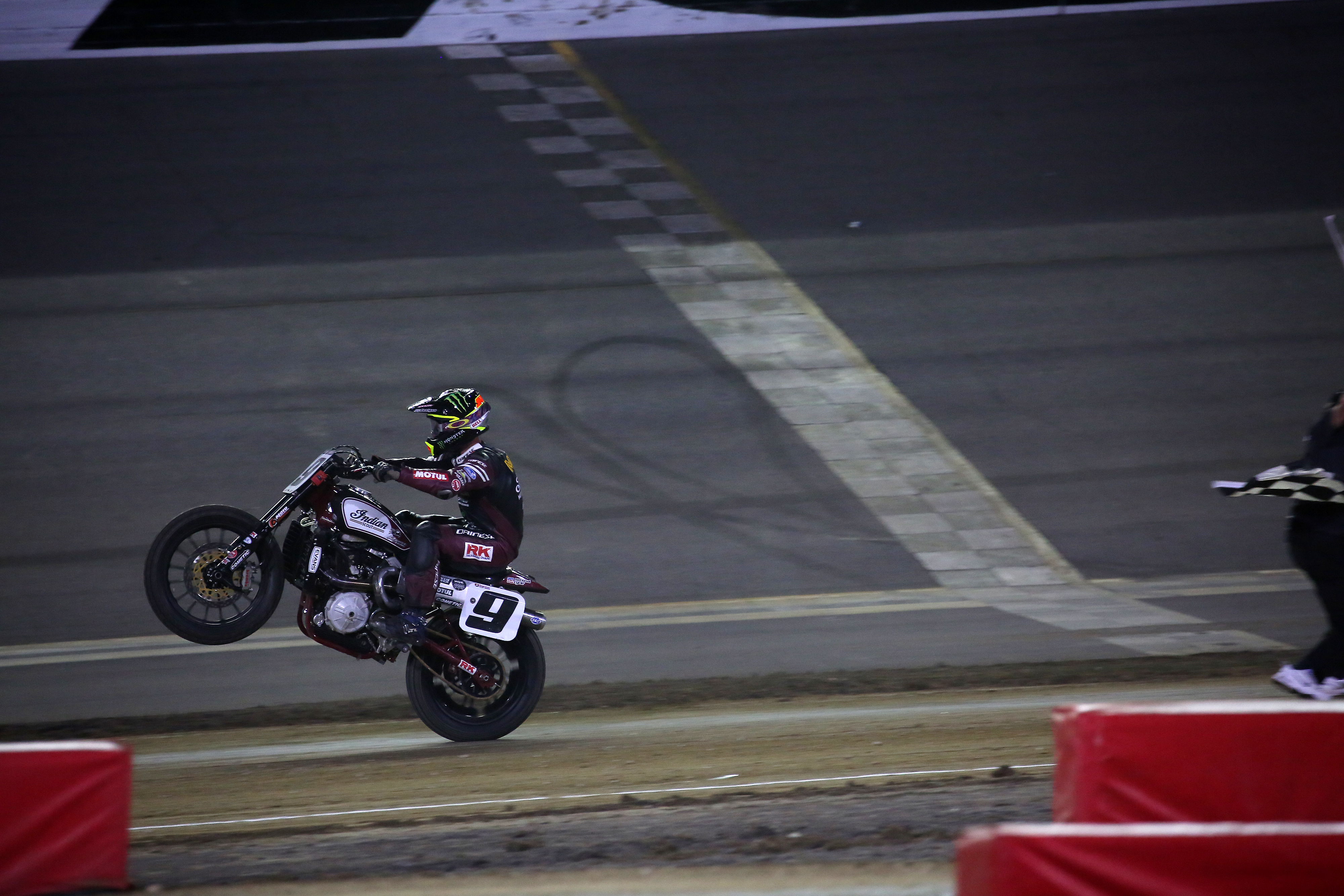
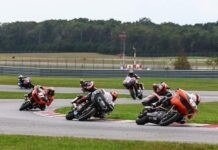
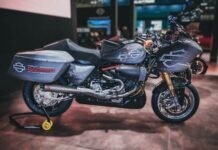
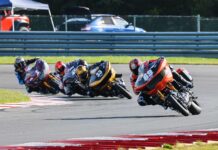


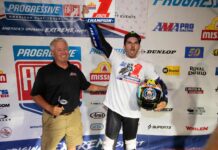










Well told story Jim… Thanks and hope to see you again on the AFT trail in 2017.
Like to know the technical details of the Indian that led to the “dethrone” Harley. Was it more the racer or machine?